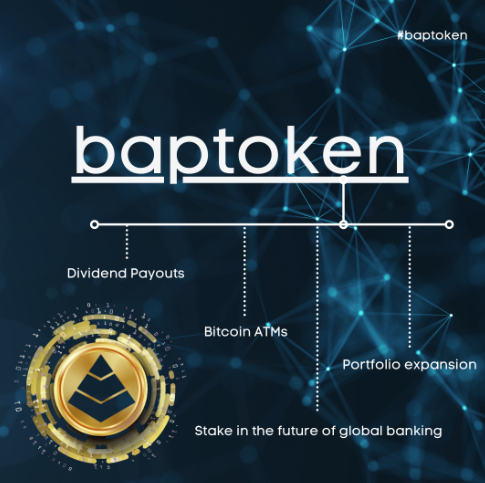Bitcoin ATM Pros (BAP) advances decentralized finance with a new digital asset and crypto ATM
SAN DIEGO, California, 20 Sep 2021, ZEXPRWIRE, Since decentralized finance (DeFi) goes against the rules of “traditional” centralized finance, the dispute over whether decentralized finance is an acceptable alternative is raging. Centralized systems, such as banks, have been at the forefront of the global financial industry for a long time. However, the financial landscape has been cluttered with disparities in global financial institutions as a result of economic meltdowns. As a result, DeFi has emerged as one of the most viable options for addressing current concerns about transaction security, transparency, and access to financial services.
Prior to the introduction of DeFi, the norm for trading cryptos was centralized finance. All crypto trade orders are processed by a central exchange in centralized finance (CeFi). The central exchange is administered by specific individuals who manage the funds. This means users don’t have access to their wallet since they don’t have a private key.
With a traditional cryptocurrency exchange, users send funds to the exchange, like Binance Kraken, or Coinbase, and then manage them in an internal account. Despite the fact that funds are housed on the exchange, they are maintained outside the users’ control and are exposed to threats if the exchange’s security procedures fail. As a result, centralized exchanges have been hit by a variety of security attacks. Customers on centralized exchanges are comfortable revealing personal information and placing funds in the custody of these organizations because they believe central exchanges are trustworthy.
Furthermore, large exchanges have entire departments with customer support staff available to assist customers. The excellent quality of customer service gives customers a sense of security, reassuring them that their finances are in good hands.
CeFi essentially combines the functions of traditional finance systems by allowing people to earn interest on their loans. Unlike most financial institutions, however, access to Bitcoin is the only requirement for collateral. In conclusion, you receive interest on loans since the platform leverages your bitcoin to make further BlockChain investments. Several investors and money lenders have profited handsomely from the centralized finance system thanks to CeFi platforms. CeFi’s entire goal is to build a closed financial system that benefits both consumers and investors. Consumers have always been subjected to rigorous terms and conditions in closed financial systems. However, since the evolution of centralized finance, people can now be confident that their investment in the system will pay off.
On the other hand, in a decentralized exchange, no exchange is involved. The entire process is controlled by automated programs built on top of blockchain technologies. Decentralized finance also offers an open and fair financial system in which anybody can participate. It uses blockchain technology to give financially underprivileged people access to financial and banking services. DeFi seeks to create a financial services ecosystem that is open-source, independent, and transparent. Borrowing, yield farming, crypto lending, asset storage, and other services are available through the decentralized financial system. The advantage of DeFi over CeFi is that people have complete control of their assets and own the wallet’s key. Users who want to engage in DeFi must do so using decentralized applications (dApps) created on blockchain platforms.
Over the last year, Decentralized Finance (DeFi) has swept the cryptocurrency market, catapulting various projects and tokens into the limelight. The progress made in the DeFi space is the reason why so many people are looking to the future and realizing the potential DeFi has to disrupt the traditional financial system. With record valuations in Ethereum-based DeFi platforms and a plethora of top-performing DeFi tokens showing impressive results, many people are looking to DeFi as a viable alternative.
With DeFi emerging as a viable alternative for CeFi, it has gotten significantly more popular. However, in order to fully understand the potential of DeFi from a neutral perspective, it is important to also understand the risks in DeFi. The three main types of risks when it comes to DeFi include financial, procedural, and technical. Technical risk is directly related to hardware and software difficulties. Technical risks are a big source of concern since they can affect the general functionality of any platform. Other technological hazards in DeFi, such as smart contracts, software, and hardware, are also dependent on smart contracts, software, and hardware. Smart contract risks are almost unavoidable due to their function in promoting automation. These risks have the potential for defects that could constitute a technical risk to DeFi. The way that crypto enthusiasts use DeFi products or services can also provide procedural risks that can undermine security. This is nearly identical to technical risks, with the exception of the end-user relationship. Procedural risks are among the “Top 5” prominent dangers that can arise in the DeFi environment. Most of these procedural risks are surrounded by the numerous security issues that users and consumers may have when using DeFi products and services. Phishing attempts, in which a hostile actor imitates a website or service to deceive naive users into disclosing sensitive information, are some of the most common security hazards in DeFi.
Lastly, DeFi does not come without financial risk. Whether or not this discourages investment in DeFi depends on an organization or an individual’s risk tolerance as well as their goals for managing a successful investment portfolio. Financial risk assessments can help users make better decisions about how to utilize DeFi platforms and services since they determine the potential of losing money. Enterprises, on the other hand, must balance money management for business operations while focusing on financial risk. Finally, in the case of governments, financial risks are determined by how funds are managed and distributed among multiple systems and solutions.
San Diego-based company, Bitcoin ATM Pros (BAP), has an understanding of the gaps that need to be filled in the crypto ATM sector. With this knowledge, BAP has created a multi-utility token that pays out a quarterly dividend to holders based on 10% of the fees generated by their crypto ATMs. They are attempting to expand their ATM reach worldwide to serve people who are underserved in the category of digital asset availability. Their ATMs have a buy and sell option thanks to their MSB licensing through FinCEN. A percentage of every investment goes directly into additional ATM placements around the world, thus helping them expand rapidly. Ultimately, BAP is determined to provide the financially underprivileged with easily accessible money transmitting services.
For more information about BAP, click here.
About Bitcoin ATM Pros
Bitcoin ATM Pros has launched BAP token – a multiple-utility token that earns holders a 10% dividend from their crypto ATM fees. Since BAP token has MSB licensing and is a money transmitter through FinCEN, BAP ATMs offer both a buy and sell option. With their cryptocurrency, Bitcoin ATM Pros aims to provide the financially underprivileged with easily accessible money transmitting services.
Media Contact –
Website: https://www.baptoken.com/
Facebook: https://web.facebook.com/BitcoinATMProsOFFICIAL
Instagram: https://www.instagram.com/bitcoinatmpros/
Medium: https://bitcoinatmpros.medium.com/
Twitter: https://twitter.com/BitcoinATMpros
Email: [email protected]
Phone: 858-444-7222


